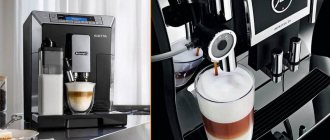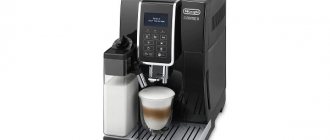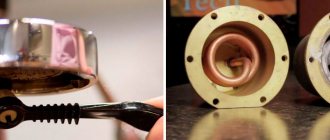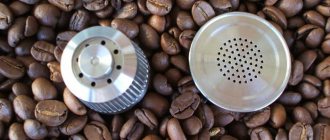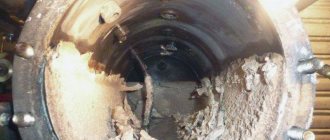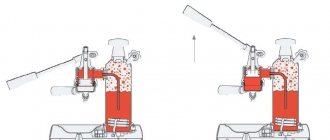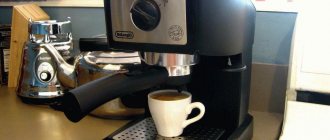When purchasing a coffee machine, we dream of how we will enjoy a fragrant, invigorating drink every morning, recharging ourselves with energy and a good mood for the whole day. At this stage, it doesn’t even occur to us that the device requires regular maintenance. And timely cleaning of the coffee machine is the key to obtaining delicious coffee, as well as a long service life of an expensive device.
Why clean your coffee machine?
Coffee machine service specialists assure that without regular cleaning, the device will last no more than 7–8 months. After this you will have to contact the service center. And let’s not even talk about delicious coffee. The fact is that the operation of the device is characterized by the following processes:
- the heating elements of the coffee machine become covered with scale - salt deposits destroy plastic and metal parts, increase the amount of energy consumed and the duration of preparation of the drink, and the taste of the coffee significantly deteriorates,
- the hydraulic system becomes clogged with sediments of coffee oils - it becomes difficult for water to seep through, the load on the mechanism of the device increases, the oils oxidize over time, acquiring an unpleasant taste and smell, which become the highlight of every cup of coffee,
- the internal mechanism of the cappuccino maker becomes covered with a milky coating - this is an excellent environment for the growth of bacteria,
- The liquid accumulated in the pan begins to emit a musty odor, and mold may form.
How often should you clean your coffee machine?
Cleaning a coffee machine involves:
- descaling (decalcification),
- getting rid of coffee oils,
- cleaning the cappuccino maker and milk jug,
- care for other parts - the pulp compartment, millstones, tray.
It is important to clean each part of the device regularly and with a certain frequency.
How to understand when it's time to descale
When the time comes to decalcify, a corresponding message will appear on the device display or a special indicator will light up (see instructions). However, not a single coffee machine has sensors that would detect the amount of scale. The devices count the cooked portions and, upon reaching the milestone specified by the manufacturer, inform the owner about the need for cleaning. But the rate of scale formation directly depends on the hardness of the water: the more impurities it contains, the more actively salts are deposited on the heating elements. Therefore, before using the coffee machine, it is recommended to set the water hardness level. You can check this value using a special indicator strip that comes with the device.
The process of programming hardness for a specific coffee machine model is carried out in accordance with the instructions. And now the number of servings after which the device will need to be cleaned is determined depending on the specified indicator.
It is recommended to descale immediately after the appliance informs you that it is necessary to do so.
Some coffee machines equipped with a built-in water purification filter may not indicate at all that the device needs cleaning. A priori, it is believed that the liquid being poured is crystal clear and no scale is formed. But even in this case, experts recommend decalcification at least once a year.
The following “symptoms” indicate that it’s time to descale:
- the stream of coffee flowing into the cup is thinner than usual,
- white sediment in the drink,
- loud noise during operation of the device,
- The taste of the coffee deteriorates and its temperature decreases.
Prevention of rapid scale formation is to use soft water purified with a household or special filter for a coffee machine. But the most effective option is the use of a reverse osmosis purification system. It includes a filter with a special membrane, the pores of which are comparable in size to water molecules, i.e. it is permeable only to particles whose diameter is equal to or less than the diameter of water molecules. The liquid passes through the membrane and is cleared of substances dissolved in it.
Frequency of getting rid of coffee oils
A pour-over type coffee machine is equipped with a brewing unit, which during operation becomes clogged with oils and particles of ground coffee. There are two types of infusers:
- Removable. It must be taken out and washed under running water once every 1–3 weeks. After preparing 200–500 cups of coffee, it is recommended to clean the device using special products.
- Fixed. It must be cleaned with special products immediately after the coffee machine gives the appropriate signal (see instructions).
Owners of espresso machines in which the horn acts as a brewing unit must daily:
- wipe the steam wand after each use of the device,
- After each cup of espresso, wipe the dispersion screen with a damp soft cloth,
- Wash the filter and holder (portafilter) after preparing the drink.
You also need to back-clean the valve 1-2 times a year or more often using a blind filter - a special filter without holes that is used to clean the brew group.
Cleaning other parts
Cleaning parts that many users forget about should also be carried out with some regularity:
- water collection tray - drain accumulated liquid daily, rinse completely 1-2 times a month,
- Compartment for collecting pulp - clean immediately after the device gives the corresponding signal,
- grinders - clean every 3-4 kg of coffee,
- cappuccino maker - every day, the part with both the built-in jug and the outlet tube must be disassembled (how to do this is described in the instructions for the coffee machine) and washed.
Is it time to descale your coffee machine?
The coffee machine should be cleaned regularly. But the regularity of cleaning directly depends on the quality of the water. If the water is hard, then the procedure should be performed approximately once a month, if it is very soft - once every six months.
There is another criterion: you should think about cleaning the device after it has prepared approximately 200 cups of coffee. Some models are equipped with special counters for this and “tell” the owner when it’s time to clean. If the unit is not so smart, then you should pay attention to factors such as:
- the stream of coffee pouring into the cup becomes much thinner than usual;
- strong hum;
- the appearance of a whitish sediment in the drink.
If such signs appear, then you should start preparing for the fact that you will have to descale the coffee machine.
Getting rid of scale
To properly descale the appliance, you need to know how to carry out the procedure and what products to use.
Cleaning procedure
The descaling process depends on the specific coffee machine model. Its essence is that water with a cleaning agent diluted in it is passed through the internal mechanism of the device and frees the heating elements from salt deposits. It is necessary to strictly follow the recommendations described in the instructions.
Instructions for any device can be found on the Internet, so do not despair if the accompanying brochure is lost.
The sequence of actions for the cleaning procedure is as follows:
- Pour water with decalcifier dissolved in it into the water tank.
- Start the brewing process, but without coffee.
- Repeat 4-5 times.
- Carry out the operation 2–3 more times, but with clean water.
Cleaning of more expensive machines is usually automated: just place the cleaning agent and with one press of a button start the descaling process by activating the descale or calc mode. The process usually takes 15–20 minutes.
Video: descaling a coffee machine (using Delonghi as an example)
What products should I use to descale coffee machines?
In the instructions for a specific coffee machine, as a rule, it is recommended to use products of the same brand as the device itself. Branded cleaners are produced by Philips Saeco, DeLonghi, Bosch and other companies. However, experts believe that products from any other brand are suitable for any coffee machine. You shouldn’t be afraid of universal products designed for decalcifying coffee machines, for example, Top House or Topperr 3006.
Experts assure that among branded decalcifiers it is better to choose products from Melitta, since they are the cheapest and are all approximately the same in effectiveness.
Commercial descaling products come in the form of:
- liquids,
- powder,
- tablets.
The effectiveness of the product does not depend on its form. Any product is mixed with water, and the tablets and powder must dissolve without residue. The dosage depends on the product used and is described in the instructions.
Such products are usually labeled accordingly on the packaging: for descaling, for decalcification, descaling, calc, decalcifier, etc.
Table - overview of purchased decalcification products
| Cleaner type | Name | Characteristic | Approximate cost at the beginning of 2021 (in rubles) |
| Liquid | Top house "Coffee machine and coffee maker cleaner" |
| 220–260 |
| TOPPERR 3006 “For descaling coffee machines” |
| 250–300 | |
| DeLonghi DLSC500 |
| 1500–1700 | |
| Philips-Saeco CA6700/00 |
| 670–700 | |
| Melitta "ANTI CALC for fully automatic coffee machines" |
| 350–400 | |
| Powder | Melitta "ANTI CALC for fully automatic coffee machines" |
| 350–400 |
| Neodisher CM special |
| 2200–2250 | |
| Pills | Bosch TCZ8002 |
| 650–700 |
| Top house “Anti-scale tablets for teapots, coffee makers and coffee machines” |
| 350–400 | |
| Filtero “Anti-scale tablets for coffee makers and coffee machines” |
| 230–250 |
Photo gallery: decalcifiers for coffee machines
One package of Melitta liquid “ANTI CALC for fully automatic coffee machines” is enough for two cleanings of the device
Branded tablets for cleaning coffee machines from scale Bosch TCZ8002 quickly dissolve in water and clean the device well
Filtero tablets are valued by users for their high-quality descaling and affordable price.
Philips-Saeco CA6700/00 packaging - liquid for descaling coffee machines - designed for one use
TOPPERR 3006 “For descaling coffee machines” - an inexpensive decalcifier
Is it worth using traditional methods?
The most economical option is to use home remedies. However, experts warn that you can resort to such methods at your own peril and risk: only products specifically designed for removing scale from a coffee machine can guarantee the safety of the device’s mechanism.
Popular rumor recommends using 9 percent vinegar, diluted with water in a ratio of 1 to 3, and Coca-Cola. But the use of these substances for cleaning devices is contraindicated, as they can damage rubber gaskets and other parts of the mechanism. Also clean the coffee machine with a solution of citric acid (10 g per 1 liter of water). This method can rarely be used as a last resort. It is not suitable for constant maintenance of the device: the effectiveness of the product is much lower than that of industrial products, but its use can have a negative impact on the condition of the internal structure of the coffee machine.
Control
There is nothing complicated in operating this coffee machine. It is 100% mechanical. But it’s better to read the instructions first, since users often fail to make high-quality coffee the first time. Any Bosch TCA 5309 button is responsible for a separate function. For example, there is a button that allows you to select the serving size. There is also a button to turn on the cappuccino maker and adjust the degree of grinding. There is also a special button responsible for changing the amount of steam supplied and its pressure if you need to use a cappuccino maker. Overall the management is good. The interface is actually not overloaded and will be completely understandable for anyone. A beginner can handle this machine. Therefore, it is recommended to highlight: ergonomics is a well-implemented nuance of the Bosch TCA 5309. You can also choose a function in which all characteristics are set manually.
There are a huge number of positive and negative reviews. Consumers praise the assembly, materials, functionality, and also highlight the mode that allows you to automatically wash the car. In particular, people note the taste of brewed coffee. The Bosch TCA 5309 device allows you to drink not only a perfectly fragrant drink, but the quality is no different from professional. Naturally, it is necessary to use only expensive grains and better bottled water. Then the greatest effect will not be expected. Many people praise the cappuccino maker. He can whip up any kind of milk in order to add it to a drink.
As for negative reviews, buyers usually describe a manufacturing defect. Therefore, when choosing, you need to carefully examine the car and check for flaws. Some complain that this device brews weak coffee. But this is a matter of taste, marriage has nothing to do with it. You must receive the device only at specialized points of sale.
How to descale a Bosch coffee machine at home.
Even German quality is unable to protect the coffee makers of this popular manufacturer from limestone. Therefore, proper cleaning of your Bosch coffee machine is an urgent necessity.
Cleaning the device from coffee oils
Removing coffee oils means cleaning the hydraulic system of the coffee machine. The method depends on the type of device.
Pour-type coffee machine
Operating procedure:
- Disconnect the removable brewing device and rinse with running water.
- Clean the strainer holes clogged with coffee residues using a soap solution, brush or needle.
- Install the element back after it has completely dried.
Cleaning using special means (both removable and non-removable brewing unit) is carried out in strict accordance with the instructions for the device. Typically, the algorithm is as follows:
- Place an oil remover tablet into the ground coffee chamber.
- Install the “Ground Coffee” program.
- Place a cup under the dispenser and activate the largest volume of espresso brewing.
- Drain the released water (as a rule, the liquid comes out white and with a foam similar to soap).
- Prepare coffee 2-3 times, but do not drink it, but pour it into the sink.
- After 30 minutes, repeat the procedure 2-3 times with clean water.
Products for cleaning coffee machines from oils
Cleaning from coffee oils is carried out using tablets with the appropriate markings: cleans, clean, cleaning, for cleansing coffee oils, etc. Judging by the reviews, they have proven themselves well:
- Topperr 3037,
- JURA,
- Melitta 1500791,
- Bosch 311769,
- Cleancaf Urnex,
- Neohome,
- Filtero 613 and others.
The most affordable coffee oil tablets are produced by Melitta and Bosch. On average, one cleaning costs 250 rubles. It’s even cheaper to buy similar products from Topper 3037 (35–40 rubles per cleaning).
Video: cleaning the device from coffee oils (using Jura as an example)
Espresso machine
Carob-type coffee makers are cleaned of oils as follows:
- Pour cleaning powder into the blind filter or place a tablet in the holder.
- Install the portafilter into the brew group.
- Turn on the spill cycle for 10 seconds.
- Repeat the sequence (turn on the spill - turn off - wait) 5 times. After this, water should be discharged from the brewing group into the drip tray, which is accompanied by a characteristic sound of water being drained.
- Loosen the horn, but do not remove it from the brew group head.
- Turn on the water supply: the liquid will put pressure on the blind filter and will soon begin to overflow. At this point, you need to start tilting and rotating the horn for more effective cleaning.
- Take out the portafilter and start pouring water to wash the divider; rinse the holder itself with running water.
- Repeat steps 1–6 with clean water without a special product to clean the system of chemicals.
- Clean the threads of the group head and the edges of the dispersion screen using a toothbrush.
- Wash parts.
If necessary, the holder, filter and tube tip are cleaned by soaking in the solution:
- Dilute the cleaning powder in water (see dosage in the instructions for the specific product).
- Immerse the parts in a container with the solution for half an hour.
- Clean off dirt and rinse thoroughly in plenty of running water.
What tools to use
Typically, powders are used to remove oils in carob coffee machines, for example:
- JOEGLO "Espresso machine cleaner"
- ASCACO "Cleaning agent for removing coffee oils from espresso coffee machine elements",
- PULY POWDER Plus “Cleaning agent for espresso coffee machines”,
- Urnex Cafiza 2 “Cleaning agent for espresso machines.”
There are also products in tablet form, for example Cafiza E16 “Cleaner for espresso machines and super-automatic machines”.
Cleaning the milk jug and cappuccino maker
The automatic cappuccino maker is cleaned as follows:
- Instead of a container with milk, place a container with clean water.
- Activate milk supply.
- Drive 50 ml of water or more in this way until clear liquid begins to come out.
If this procedure is carried out regularly, you can do without chemicals.
If you use old milk or skip cleaning, you may need to use special products:
- Urnex Rinza “Liquid for washing milk systems”,
- WMF cleaner cream milk,
- Neodisher "Detergent for cappuccino maker",
- Topperr 3041 "Dairy system cleaner".
In this case, water with the product dissolved in it is driven through the device (see the dosage in the instructions for the specific product).
Video: how to clean the cappuccino maker
What to clean with?
As a rule, all manufacturers make special products for decalcifying their devices. Recommended “drugs” are usually indicated in the instructions already mentioned above. However, there are also universal means that may well serve as their replacement.
In principle, you can do without branded chemicals and use folk remedies, for example: lemon juice. Using this product you can even clean an electric kettle from scale or, for example, an oven from grease. Hence the conclusion: citric acid is not only a food additive.
Cleaning other parts
The body of the device should be regularly wiped with a soft damp cloth to remove dust and other contaminants. It is important to promptly drain the liquid accumulated in the pan to avoid the appearance of mold and musty smell. Also, 1-2 times a month you need to wash this part with running water or in a dishwasher at a temperature of no more than 60 °C. It can be reinstalled only after thorough drying.
Compartment for pulp
The pulp compartment must be removed while the machine is turned on. After emptying, rinse it with running water and wipe dry.
If you empty the hopper while the device is turned off, the coffee cycle counter will not reset and the message about the need to empty the container will not disappear from the screen.
Coffee grinder
Cleaning the millstone mechanism is carried out as follows:
- Empty the bean hopper of coffee.
- Activate the grinding mode to get rid of the remaining grains.
- Place the tablet or powder into the hopper.
- Turn on grinding for 5-6 seconds.
- Fill the compartment with grains.
- Prepare 2-3 cups of coffee, pouring the drink down the sink each time.
As a cleaning agent, powder made from food starch is used, which absorbs accumulated fats, or special tablets, for example, Puly grind.
Features of cleaning capsule coffee machines
To clean a capsule coffee machine, do the following:
- decalcification is carried out every few months (depending on the degree of water hardness), for this purpose the cleaning solution is poured into the water tank and circulated through the system several times by activating the coffee brewing mode, then the sequence is repeated several times with clean water,
- The role of the brewing unit in such devices is played by the capsule, so removal of coffee oils is not required,
- Most machines of this type do not have a milk circuit; if there is an element, cleaning is carried out in the same way as described above.
Regular cleaning of the coffee machine is important for its long service life and obtaining a tasty, aromatic drink. Do not neglect simple procedures so that you do not have to repair the device soon.
Stages of the long journey...
How to clean a coffee machine with citric acid will be discussed a little later. First, let's talk about how to clean using manufacturer-recommended or universal cleaning products.
If the machine belongs to the “smart” category, i.e. has a display and a counter for brewed cups of coffee, then everything is simple.
- Prepare the solution according to the instructions.
- Pour it into the water tank.
- Empty the waste container of coffee residues.
- Start automatic cleaning and follow the instructions that the coffee machine itself will periodically give (most often it requires adding water and cleaning the tray again).
The machine will do the rest on its own.
If such a function is not provided by the unit’s designers, then proceed as follows:
- Prepare the solution according to the instructions on the package.
- Pour it into the water tank.
- Clean the waste container and filter from coffee residues.
- Turn on the device and open the tap, from which boiling water should flow. You need to drain 100-150 ml of liquid.
- Repeat the draining procedure 4-5 times approximately every 5-7 minutes, draining 80-100 ml of liquid.
- If the device is not equipped with a sprayer, then add coffee and start the preparation program without draining the cleaning solution. If there is a pulver or the coffee maker is of the carob type, then the program can be started without pouring coffee.
- Pour out the resulting “drink” (you should absolutely not drink it!!!) and repeat the procedure until the poured solution runs out.
- Rinse the water tank, fill with cold water and repeat steps. 3 – 7.
- Rinse the working unit of the unit with running water.
Ready! The coffee machine is now clean and able to brew normal coffee again.
Of course, the above are general cleaning principles. For example, some coffee machines are equipped with special containers where the cleaning agent is placed in tablet form. So, in any case, you should first read the instruction manual.
